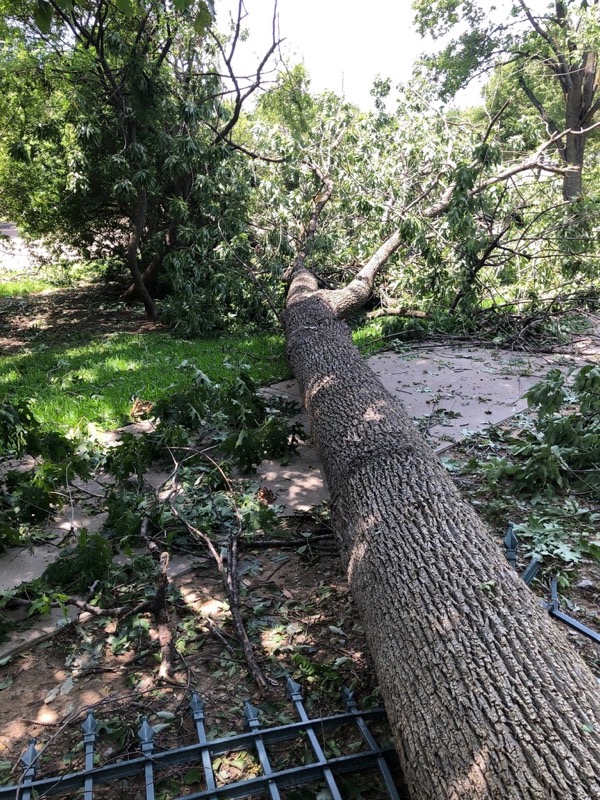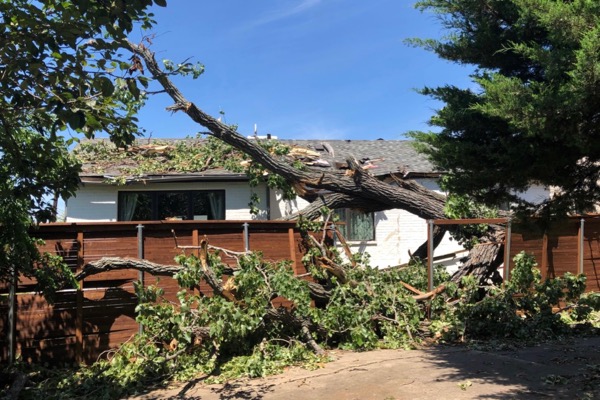
Texas Trees Foundation offers advice to homeowners dealing with tree damage. Photos by Dick Guldi.
June 11, 2019
Sunday’s severe storms in North Texas made national news after 350,000 residents lost power and a crane collapsed, killing one Dallas resident.
In addition, tree lovers were stunned by the extent of the damage to trees across the DFW region.
“We’re estimating several hundred to a thousand trees knocked over,” said Taylor Nelson, spokesperson for the Texas Trees Foundation, a Dallas-based tree advocacy group.
 Nelson said the storm’s high winds - up to 70 mph - were responsible for the damage. And while some local environmentalists pointed the finger at climate change, Nelson speculated that some trees may have been more vulnerable than others due to improper maintainance.
Nelson said the storm’s high winds - up to 70 mph - were responsible for the damage. And while some local environmentalists pointed the finger at climate change, Nelson speculated that some trees may have been more vulnerable than others due to improper maintainance.
“It’s a blessing in disguise in a way because it’s shifted people’s attention to the importance of trees,” he said.
According to Texas Trees Foundation, the storm offered two important lessons with regard to tree planting: First - always plant the right tree in the right place. Large trees near power lines will result in electric outages during storms. The second lesson, trees need care. Many of the trees that had broken limbs had poor canopy structure leading to ingrown bark and weak points. Poor pruning cuts, disease and insects predispose trees to structural failure during heavy wind events.
Nelson said hiring qualified certified arborists to prune and care for your tree is an important step in eliminating problems during storms.
Texas Trees Foundation offers the following insights for North Central Texas residents and businesses impacted by the severe storms.
When you hire an arborist ask the following questions:
1. Are they an ISA Certified Arborist? Ask to see their identification card.
2. Can they provide proof of insurance? Ask to see it.
3. Are they reputable? Ask for references.
4. Do they provide a free written estimate?
5. Will they top your trees? If they will, find someone else.
Corrective pruning and maintenance after a storm is important. Qualified arborists know what steps to take and how to work safely leaving you less liable in case an accident happens. Believe it or not, most storm damaged trees can be saved with proper care. Have your damaged trees inspected as soon as possible by a professional and pruned as needed. If you are going to prune your tree yourself remember – never prune trees near power lines and always follow correct procedures for pruning. See correct pruning techniques here.
 Additional information regarding the pruning of storm damaged trees may be found here.
Additional information regarding the pruning of storm damaged trees may be found here.
If replanting trees, make sure to pick the right tree for the right place. Don’t plant large trees near power lines and make sure that the mature size of the tree, both in width and height, are considered. To find a list of trees specific to Texas go to the Texas Forest Service website.
“Trees play a critical role in the health and well being of our communities. They clean our air, slow water runoff, lower energy costs, increase property values, and provide a plethora of other benefits. Investing in your trees will pay off,” said Janette Monear, CEO of the Texas Trees Foundation.
Stay up to date on everything green in North Texas, including the latest news and events! Sign up for the weekly Green Source DFW Newsletter! Follow us on Facebook and Twitter.









